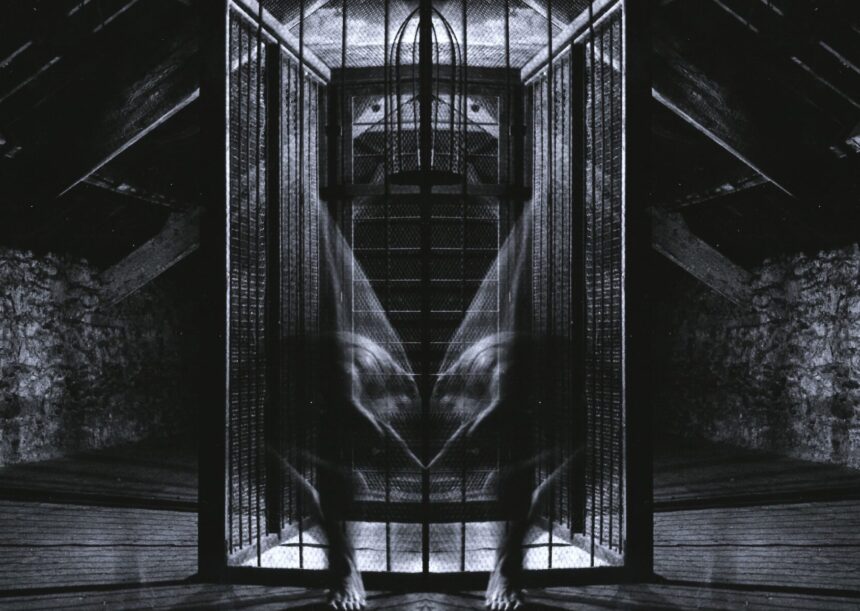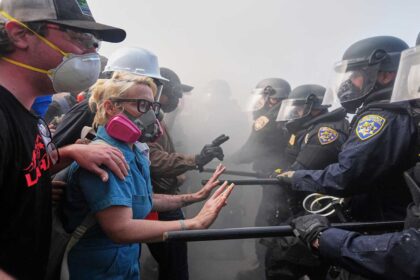Enclosure and Capture: The Paradox of Opacity/Legibility
Kevin Ryan
The Thought of the Outside
When I began working on this essay to mark the tenth anniversary of FIELD: A Journal of Socially-Engaged Art Criticism, my intention was to focus on how FIELD navigates the relationship between the field of socially/politically engaged art and what policy pundits refer to as “the cultural and creative industries”. The latter of course profit by recuperating disruptive and transgressive forms of creative labour that operate outside of the institutional apparatus, thereby blurring the boundary between “inside” and “outside”. Deeper reflection however has prompted me to shift my focus to “the thought of the outside”[1] in a more abstract sense, because as the world becomes ever more broken, critical forums like FIELD shoulder a heavy burden of responsibility. My starting point is to adapt Marquis Bey’s argument in their Black Trans Feminism, and propose that engaged art should care less about “ontologised” art, which is the currency of the institutional apparatus[2]. Why care less? Because so much more is at stake.
This is not to suggest that the issue of institutional capture is unimportant, as Greg Sholette reminds us in his Delirium and Resistance. In a chapter titled “Fidelity, Betrayal, Autonomy”, originally published in 2003, Sholette looks at how “the institution and its antagonists converge”, and he goes to the heart of the matter by posing a question–if “the institution is an apparatus of capture” then “what does it seize?”[3] So, can engaged art prevent–here borrowing from Grant Kester–its “transgressive criticality” and “transformative potential” from being seized?[4] If Sholette is correct, we might as well lean into the inevitability of capture, because there is no autonomous and uncontaminated “outside” that offers sanctuary to the mission of a critical and transformative art. This is why Sholette enjoins “us faithless intellectuals, artists, curators and administrators” to “actively forget the convoluted nature of our predicament”, which otherwise gets in the way of “the radical potential already present in collective action”[5]. Active forgetting[6] sounds a bit like willed amnesia, which is something I’m inclined to be wary of, because it sails close to the wind of historical erasure as practised by neo-fascists, but there’s no doubting the accuracy of Sholette’s description of the predicament. The problem of capture is indeed convoluted, at once within and without the institutional apparatus. What follows from this insight is the need for tactical awareness regarding the thought of the outside. I suggest framing this tactical awareness as a paradox of opacity/legibility, which is operative in a situation characterised by a resurgent and pervasive anti-Blackness.
It hardly needs stating that the global situation right now is bleak, but not devoid of hope, and the transgressive/transformative capacity of engaged art is a mode of political agency capable of converting hope into experimental practice. There is an urgency to this. The executive power wielded by demagogues such as Viktor Orbán, Donald Trump and Narendra Modi poses a direct threat to democracy, but arguably more dangerous is the entanglement of demagoguery and what Richard Seymour describes as an “incipient fascism” operative at the “molecular” level of social relations[7]. Incipient fascism is reminiscent of Karl Schmitt’s notion of “the political”[8], which plays out as “friend” v “enemy” scenarios, such as nativist nationalists demonising “immigrants” in Europe, white supremacists attacking Black Lives Matter activists in the US, and pervasive anti-Muslim violence in India. Channelling phobia and resentment into anger and hatred, the inchoate fascist tendencies that Seymour documents are evidenced in the violence of lone-wolf killers, the “pogromist populism” of mob violence, and the “participatory sadism” orchestrated via online media platforms[9]. Neither does this resurgent anti-Blackness spare people framed as “woke” – people like me who are not black, but who are committed to Blackness as a mode of criticality. The engaged art documented, analysed and archived by FIELD is an ally to Blackness, which, as argued by Bey, aligns with transness and feminism when figured as a project that Bey calls “abolitionist gender radicality”[10]. If the task is to abolish anti-Blackness, then it begins with a politics of refusal.
As a commitment to imagining and struggling for other worlds and “livable life”[11], a politics of refusal hinges on what Kester refers to as “the mode of political transformation”, which is how he maps distinctive temporalities apropos of contemporary engaged art relative to the traditional avant-garde. Kester distils the temporality of the avant-garde into a “principle of deferral”[12], meaning that political transformation is projected into a future that never arrives, deferred because the conditions required to actualise the envisioned future are presumed to be absent. Consequently, the avant-garde acts as the custodian of a revolution-in-waiting that is both present (in the consciousness and agency of the avant-garde artist/intellectual) and absent (as the “incapacity of the masses”)[13]. I am simplifying for ease of presentation, but the point I want to make concerns the assumed “beyond” or “outside” that makes this temporality plausible, or rather, once gave it a plausibility that no longer applies. Evading capture on the way to abolishing anti-Blackness is to practice fugitivity, but the temporality of fugitivity, and hence also the project of abolition, has no destination-as-destiny[14]. To be fugitive is to move in the wake of “a past that is not past”[15], and so the possibility of freedom is also an impossibility. This is surely an insight that marks the transition from avant-garde to engaged art–the awareness that whatever is to be done can only be done in the here and now, and doing it means doing it together.
If a metaphysics of plenitude-to-come is what enables us to endure the present in the expectation that we will eventually put the debilitating brokenness of the world behind us, then that kind of therapeutics is best left to the metaphysicians. That said, an abolitionist politics of refusal remains in an inescapable relation to what is refused, and thus in some form of direct or indirect dialogue with the onto-epistemological apparatus of capture. The name I will use to frame this apparatus is “enclosure”[16], noting that it needs to be grasped in terms of its scope and internal complexity. By scope I mean its temporal and spatial reach, and by internal complexity I am referring to a living matrix of power relations, which is to say that power lives in how we live within enclosure.
What I have outlined thus far anticipates the paradox of opacity/legibility. Without the thought of the outside, how would transgressive and transformative desires exist as anything other than a yearning for something that cannot be described, expressed, or given aesthetic/discursive form? Absent the thought of the outside, it is difficult to imagine anything more practical than hunkering down and hoping for the best. And yet, whatever is conjured as the thought of the outside is an im/possible fiction, or as Sholette puts it, a “transparent lie”[17]. Moreover, this is a critical insight that stares us in the face, not (or no longer?) a hidden truth to be revealed by avant-garde intellectuals and artists. The thought of the outside must remain opaque to the apparatus of capture, but at the same time must be legible within the field of practice. This is the convoluted predicament that Sholette identifies, and it structures the field that FIELD has arguably tasked itself with navigating.
Fugitivity: Navigating the Paradox of Opacity/Legibility
One of the ways that engaged art is captured–applicable to FIELD’s mission[18] –is by incorporating it into the history and theory of aesthetics, thereby making the field of practice intelligible. This is an aporetic scenario. On the one hand this is what makes learning and exchange possible, enabling engaged art to travel so that practitioners can study each other’s successes and failures, while also enabling specific projects to endure and outlive their durational existence. On the other hand, legibility facilitates capture. In addition to this rather obvious issue, FIELD bridges the gap that separates the experience of doing engaged art from vicarious encounters with the field of practice. By vicarious encounter I am thinking of readers and researchers (myself included) who often experience the work at a remove, relying on documentary materials such as images, texts, and critical commentary, which is yet another way that the inside/outside relation is configured. By way of bringing this opacity/legibility, inside/outside matrix into sharper focus, I will sketch an outline of Grant Kester’s theory of dialogical aesthetics.
In his Beyond the Sovereign Self, Kester identifies “a general set of characteristics associated with socially engaged art”, and does so by conducting a detailed and comprehensive historical analysis aimed at ascertaining the specificity of engaged art[19]. In brief (and I’m aware that this doesn’t do justice to the depth and scope of analysis), Kester borrows from music theory in combining performance-based learning with critical cognitive reflection, which converge as a dialogical aesthetics. The characteristics of engaged art that emerge through this analytics are framed by Kester as “praxial”, spanning tactical/situated awareness, counter-normative critique, structural analysis, and prefigurative “social labour”[20]. More specifically, the theory of dialogical aesthetics corresponds to engaged art practices that generate new forms of knowledge, that establish a context for intra- and inter-subjective learning, and that translate critical thought produced through reciprocal exchange into action with a view to initiating a transformative process, all of which tends to be deeply contextual. As impressive as Kester’s analysis is–and it should be noted that the general characteristics sketched above are derived from a close and detailed reading of a rich constellation of projects from many different countries[21] – there is an elusive quality that exceeds the weave of detailed description, erudite interpretation, and critical analysis.
This fugitive excess resembles what, in his Poetics of Relation, Édouard Glissant refers to as “errantry” and “opacity” which, in the field of engaged art, is generated by the deeply contextual, situated, embodied, and relational qualities of practice[22]. The point I am making is that the general characteristics of engaged-art that Kester documents in mapping the field fail to capture the entirety of practice itself. This is not a failure on Kester’s part. There is an opaque quality to engaged art that escapes codifiable characteristics–a fugitive quality that the apparatus/grammar of capture (the language games of art history, critical theory, philosophy of art, cultural and creative industries…) actively pursues. The paradox of opacity/legibility encapsulates a wayward field of praxis that, if left in the wild, troubles the ontology of Art. To bring this relationship of pursuit and errancy into relief requires a counter-grammar, mindful of what is at stake in codifying the fugitive excess of engaged art, which would be to ontologise the field and make it available for capture. I will attempt to elucidate this counter-grammar in three steps, starting with what Marquis Bey calls “paraontological Blackness”, before shifting to a grammar of “the hold”. This in turn will lead to the aesthetics of power relations as a way of figuring the relationship between FIELD and field.
Paraontological Blackness: Losing Power in the Hold of (Anti-)Blackness
In an essay titled “The Case of Blackness”, Fred Moten argues that “what is inadequate to blackness is already given ontologies. The lived experienced of blackness is, among other things, a constant demand for an ontology of disorder, an ontology of dehiscence, a para-ontology”[23]. Moten attributes this mention of paraontology (I am dispensing with the hyphen in anticipation of where this discussion is headed) to Nahum Dimitri Chandler’s engagement with W. E. B. Du Bois and Franz Fanon, though Moten also claims to be deviating from Chandler. For Moten, paraontology provides a way of thinking about how Blackness applies “deformative or transformative pressure” to “philosophical concepts, categories, and methods”[24]. If this is an example of how paraontology is used in the field of Black Studies, then a more recent paper by Axelle Karera comes with a warning. While Moten uses paraontology to “disrupt the hegemonic and totalising logic of ontology”[25], Karera’s genealogical inquiry leads not to Chandler, but to Oskar Becker, who coined the idea of paraontology to “account for those entities that [Martin] Heidegger’s hermeneutic ontology cannot grasp”[26]. The detail of Karera’s analysis need not detain us here, suffice to note the substance of the critique–that paraontology is the child of Oskar Becker, and thus the grandchild of Martin Heidegger whom Becker so admired, and as a result, originates in their fascistic leanings. Heidegger’s Nazi credentials, or the extent to which his affiliation with National Socialism is reflected in his philosophy, remains a matter of debate. The same cannot be said of Becker. An admirer of Heidegger, Becker nevertheless expressed disappointment at Heidegger’s ‘turn’ post-Being and Time.[27] It is by engaging critically with what Karera refers to as Heidegger’s ‘fundamental ontology’ (Dasein or human Being), that Becker formulates his theory of paraontology, which he divides into three categories: the suprahistorical (corresponding to mathematical and logical truth); the subhistorical (nature), and the prehistorical (the ‘primitive’, encompassing notions of birth, natality, and childhood).[28] It is at the intersection of these categories that Becker’s reworks Heidegger’s ontic/ontological distinction, formulating his blood and soil ‘mantic’ phenomenology as a relation of ‘para-ontological equality’ between beings and Being. In short, by paraontology, Becker has in mind a vitalism that he equates with birth and ancestry as the condition of possibility for human existence as ‘unbroken humanity’, meaning generational existence, racial belongingness, and homeland.[29]
This is what is at stake in Karera’s critique, which cautions against using paraontology as a register of refusal, because this is to risk acquiescing to the very thing that is refused. In more pointed terms, “the trajectory of the term ‘paraontology’ cannot be disentangled from its very unusual escape from the grip of fascist ideology”[30]. For Karera, that trajectory leaves in its wake an unsavoury debt that risks surreptitiously importing “Nazi conceptuality into black thought”.[31]
Marquis Bey shifts the ground on this debate by defaulting on the debt owed to Becker and Heidegger[32]. Otherwise put, the past does not own the present, and just as Bey disdains ontologised forms of capture, so they make a transgressive move in fashioning paraontology into “paraontological Blackness”. The criticality of Blackness thereby becomes an insurgent excess that refuses not just the logos of ontology, but also the possessive logic of property. The capacious properties of paraontological Blackness are made, not born, and for Bey, Blackness is “non-propriety”, meaning not exclusively a property of racialized lives[33]. What follows is crucial: anyone can practice paraontological Blackness. Moreover, for Bey (as noted earlier), paraontological Blackness indexes the intimate relationship between Blackness, transness, and feminism, which together destabilise “the purported homes of race, gender, and sexuality, the excessive fissures of the project of Man”[34]. By purported homes, Bey is calling out the strictures of onto-epistemological enclosure and also the coloniality of its “universal” subject–the normative fiction of Man. There are two related questions worth asking of this fiction: who exactly is Man, and who does not qualify as Man? The questions converge as the history of the anti-Black world. Who is Man? La Marr Jurelle Bruce tells as that Man is the subject of normative Reason (not to be confused with lower-case reason as a style of thought or mode of cognition). Normative Reason is the history of Man, and this gives us the answer to the second question concerning the many Others who constitute the onto-epistemological substance of Man by being excluded from his purported universality. As Bruce puts it, normative Reason is:
…entangled…with misogynist, colonialist, ableist, antiblack, and other pernicious ideologies. The fact is that female people, indigenous people, colonized people, neurodivergent people, and black people have been violently excluded from the edifice of Enlightenment Reason—with Reasonable doctrines justifying those exclusions.[35]
The figure of Man is the embodiment of onto-epistemological enclosure. Those who are disqualified as other-than or less-than fully human are subject to carceral logics[36], which have taken many forms within the arc of Western modernity. The “outside” or other of Man is made practical as the coffle, the barracoon, the Middle Passage, the plantation, the prison, the asylum, the reformatory school, ghettoised neighbourhoods, migrant detention centres…this is a list that requires an ellipsis to bring it to an incomplete halt. The history of Man is saturated with power relations, but these are not only oppressive and coercive. Nested within the violence of Man are generative power relations formed by mutuality, solidarity, collective defiance, shared intransigence, and the insurgency that Bey associates with the project of abolition.
The analytics of social and political power generally operates on the basis of two principles, which are not mutually exclusive and often combined. One approach decants power into finite dimensions (three dimensions in the case of Stevan Lukes[37]; four in the case of Mark Haugaard[38]), and the other partitions power relations into specific modalities, namely power “over”, power “to”, and power “with”[39]. The analytical approach tends to bring social and political power to a standstill for the purpose of explication, minimising the unruly temporality of power relations. The more significant lacuna however is the lack of attention to the aesthetics of power relations. The grammar of “the hold”, as used in the field of Black Studies, enriches the study of social and political power, and in ways that resonate with Kester’s theory of dialogical aesthetics. Attuned to embodied contexts shaped by anti-Blackness, the grammar of the hold enjoins us not to lose sight of the ways in which power lives in relation as an enfleshed sensorium[40].
The hold is more than an idea or concept that can be codified and pinned to a referent in pursuit of analytical precision. The hold is a grammar with a pulse, a beat–an aesthetic manifold that overflows the analytics of social and political power. Anchored in the archive and–as argued by Christina Sharpe–in a past that is not past[41], the hold is the history of Man as indicated above, which tracks the carceral logics and spaces that operate on the basis of what Saidiya Hartman calls a “racial calculus” that continues to devalue Black lives[42]. And yet, the hold is so much more when grasped as a dialogical aesthetics of power relations. Power is alive in the experience of holding on to each other and holding on together; in the warmth of being held (sometimes too tightly, constricting the freedom to flee the embrace of normative demands); in the snare of being beholden to others (through unconditional love, or awe, or debt, or sense of duty); in the gift of holding others without withholding; in the security of holding on to who we think we are or know ourselves to be (even as we know we could be otherwise)[43]. The hold is within but also without onto-epistemological enclosure as the thought of the outside, traversing the im/possibility of transfiguring self-other-world relations.
Viewed in this way, power relations are a living, mobile, dialogical weave of being, sensing, knowing, doing. Otherwise put, power lives in how we live–in how we relate to each other, how we relate to ourselves, how we shape and are shaped by the worlds we inhabit. We are held by others even as we hold onto others, and we are often holding onto being held while also holding onto who and what we are in the face of situations that cast the shadow of doubt upon all that we hold dear. We are held and we are holding, until the moment we let go. To let go of the hold that power has on us is to make a bid for a freedom, knowing that freedom is fugitive, elusive, more or less opaque, just out of reach. The thought of the outside is like a summons from afar that we can sense but not quite touch–a time and place beyond the edge of cognition, beyond the logic of capture. If this is what is at stake in navigating the paradox of opacity/legibility, then the relationship between FIELD and field is in the hold of paraontological Blackness–vulnerable to capture, but more importantly, a fugitive mode of companionship committed to abolishing anti-Blackness.
Kevin Ryan is a lecturer at the School of Political Science and Sociology, University of Galway in the Republic of Ireland, and a graduate of the Crawford College of Art and Design in Cork. He is the author of Refiguring Childhood: Encounters with Biosocial Power (2021, Manchester University Press), Freedom? (with Fiona Whelan, 2018, Cork University Press), and Social Exclusion and the Politics of Order (2007, Manchester University Press). His current research focuses on fugitive freedom and the aesthetics of power relations. Kevin publishes occasionally with collaborative artist Fiona Whelan under the joint name of Two Fuse (https://twofuse.com/).
Notes
1. I have borrowed this phrase from the title of an essay that Michel Foucault published in 1966, republished in Essential Works of Foucault, 1954-1984. Volume Two: Aesthetics, Method, and Epistemology, James D. Faubion (Ed) (New York: The New Press, 1998), pp.147-169. ↑
2. Marquis Bey, Black Trans Feminism (Durham and London: Duke University Press, 2022). ↑
3. Gregory Sholette, Delirium and Resistance: Activist Art and the Crisis of Capitalism (London: Pluto Press, 2017), p.45. ↑
4. Grant H. Kester, The Sovereign Self: Aesthetic Autonomy from the Enlightenment to the Avant-Garde (Durham, NC and London: Duke University Press, 2023), p.2. ↑
5. Sholette, Delirium and Resistance: 46 (original emphasis); see also Gregory Sholette, “Do We Need a Turing Test for Activist Art in a Bare Art World?”, ASAP/Journal, 3(2), 2018, pp.221-230. ↑
6. Attributing this idea to Friedrich Nietzsche and Jacques Derrida, Sholette expands on the tactic of active forgetting in an essay published in issue 4 of FIELD: “active forgetting is the tactical withdrawal of memory that simultaneously erases and makes legible the archive and its feverish hold over us”. Gregory Sholette, “Merciless Aesthetic: Activist Art as the Return of Institutional Critique. A Response to Boris Groys”, FIELD #4, Spring 2016.
7. Richard Seymour, Disaster Nationalism: The Downfall of Liberal Civilization (London and New York: Verso, 2024), pp.12, 201. ↑
8. Carl Schmitt, The Concept of the Political (Chicago and London: The University of Chicago Press, 1996 [1932]). ↑
9. Seymour, Disaster Nationalism, pp.47, 100. ↑
10. Bey, Black Trans Feminism, p. 22. ↑
11. See Judith Butler, What World is This? A Pandemic Phenomenology (New York: Columbia University Press, 2022), pp. 55-56. ↑
12. Grant H. Kester, Beyond the Sovereign Self: Aesthetic Autonomy from the Enlightenment to the Avant-Garde (Durham, NC and London: Duke University Press, 2024), pp.105, 86. ↑
13. Kester, The Sovereign Self, pp.79, 133; see also Grant H. Kester, “On the Relationship Between Theory and Practice in Socially Engaged Art”, A Blade of Grass (July, 2015), at: https://www.sholetteseminars.com/wp-content/uploads/2015/07/Grant_Kester_ABOG_Essay.pdf ↑
14. On the temporality of activist art, see Sholette, “Merciless Aesthetic”. ↑
15. Christina Sharpe, In the Wake. On Blackness and Being (Durham, NC: Duke University Press, 2016), p.13. ↑
16. See Fred Moten and Saidiya Hartman in conversation with Kameron Carter and Sara Jane Cervanak, The Black Outdoors: Humanities Futures after Property and Possession (Franklin Humanities Institute, Duke University), September 23rd, 2016 at: https://humanitiesfutures.org/events/black-outdoors-fred-moten-saidiya-hartman-conversation-j-kameron-carter-sarah-jane-cervenak/ ↑
17. Sholette, “Merciless Aesthetic”. ↑
18. See https://field-journal.com/about/ ↑
19. Kester, Beyond the Sovereign Self p.105. ↑
20. Ibid, pp. 123-125. ↑
21. See also Grant H. Kester, The One and the Many: Contemporary Collaborative Art in a Global Context (Durham, NC and London: Duke University Press, 2011). ↑
22. Édouard Glissant, Poetics of Relation, translated by Betsy Wing (Ann Arbor: University of Michigan Press, 1997). ↑
23. Fred Moten, “The Case of Blackness”, Criticism, 50(2), 2008, p.187. ↑
24. Ibid, p. 215. ↑
25. Axelle Karera, “Paraontology: Interruption, Inheritance, or a Debt One often Regrets”, Critical Philosophy of Race, 10(2), 2022, p.162. ↑
26. Ibid, p.173. ↑
27. Again, this is the subject of debate. For Thomas Sheehan, Heidegger’s turn (Kehre) should be understood as the bond of reciprocity between Dasein and Sein. For Bret W. Davis (here citing Heidegger), it marks ‘a shift from a transcendental-horizontal projection of world to “an indwelling releasement…to the worlding of the world”’. Thomas Sheehan, “The Turn”, in Martin Heidegger: Key Concepts, Bret W. Davis (ed) (Durham: Acumen, 2009) pp. 82-101. Bret W. Davis, “Returning the world to nature: Heidegger’s turn from a transcendental-horizonal projection of world to an indwelling releasement to the open-region”, Continental Philosophy Review, 47, 2014, pp. 373-397. ↑
28. Karera, pp. 172 – 174. ↑
29. Ibid, p. 176. ↑
30. Ibid, p.178. ↑
31. Ibid, p.179. ↑
32. Marquis Bey, “Impossible Life: A Meditation on Paraontology”. Ill Will (April 19th, 2023) at: https://illwill.com/impossible-life. ↑
33. Bey, Black Trans Feminism p.16. ↑
34. Ibid, p.47. ↑
35. La Marr Jurelle Bruce, 2021. How to Go Mad Without Losing Your Mind: Madness and Black Radical Creativity (Durham and London: Duke University Press, 2021), p.4. ↑
36. Bey, Black Trans Feminism, p.22. ↑
37. Steven Lukes, Power: A Radical View. 2nd edition (London: Palgrave Macmillan, 2005). ↑
38. Mark Haugaard, The Four Dimensions of Power: Understanding Domination, Empowerment and Democracy (Manchester: Manchester University Press, 2020). ↑
39. See Power: A Reader, edited by Mark Haugaard (Manchester: Manchester University Press, 2002); Political Power: The Development of the Field, edited by Mark Haugaard and Kevin Ryan (Berlin and Toronto: Barbara Budrich, 2012). ↑
40. See Glissant, Poetics of Relation; Hortense Spillers, “Mama”s Baby, Papa’s Maybe: An American Grammar Book”, Diacritics 17(2), 1987, pp.64-81. ↑
41. Sharpe, In the Wake, p.13. ↑
42. Saidiya Hartman, Lose your Mother: A Journey Along the Atlantic Slave Route (New York: Farrar, Strauss and Giroux, 2008). ↑
43. Bey, Black Trans Feminism, pp.103, 111; Stefano Harney and Fred Moten, The Undercommons: Fugitive Planning and Black Study (Wivenhoe and New York: Minor Compositions, 2011), pp.48, 92-97; Christina Sharpe, In the Wake, pp.100-101. ↑











